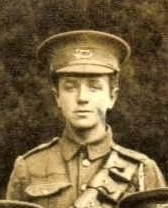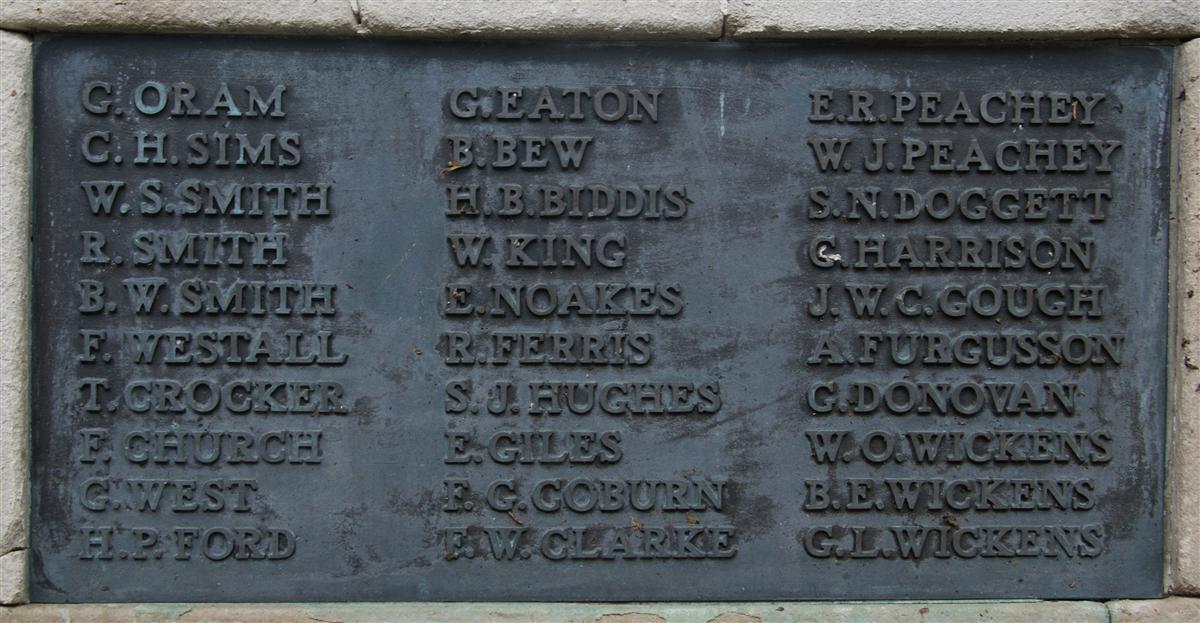Harry Brice Biddis
Trooper 1688 Harry Brice Biddis, A Squadron, Berkshire Yeomanry

Harry Biddis |
Harry was born in Newbury in 1888, the second son, third child of Henry Herbert Biddis and his wife Marion née Stratton. His father was a plumber and decorator as was his grandfather, Samuel. Samuel was also an amateur artist who presented a painting of Jack of Newbury to the Borough Council - very possibly the rather poor representation of Newbury’s most notable son which hung for many years in the Town Hall.
Henry, Marion and their family lived at 1 Florence Villas, West Street, one of a terrace of houses that was replaced by an office block (Buckingham House) in the 1990s.
After school Harry went into the family business as a plumber and decorator; at the same time he volunteered in the local Yeomanry (the cavalry arm of the Territorial Force). When war broke out he would have been called up in the early days to muster in Reading. They formed an element of the 2nd Midland Mounted Brigade. In September 1914 this brigade was attached to the 2nd Mounted Division. The following April they were shipped out to Egypt. In August they left their horses in Egypt and sailed to Gallipoli as infantry reinforcements, landing at Suvla Bay on 17 August. Four days later the Division was in reserve for an attack on a number of hills held by the Turks in an attempt to expand the Allied bridgehead at Suvla Bay.

A Squadron, Berkshire Yeomanry - Harry is fourth from right, third row. |
General Sir Ian Hamilton, Commander in Chief of the Mediterranean Expeditionary Force, had serious concerns that his troops might not be able to hold the bridgehead if they suffered too many casualties in the attempt to break out. Nevertheless he launched a series of attacks. On 21 August 1915 he sent in the 2nd South Midland Brigade. In his dispatch, printed in the London Gazette, he wrote:
Now that the 11th Division had made their effort, and failed, the 2nd South Midland Brigade (commanded by Brigadier-General Earl of Longford) was sent forward from its position of readiness behind Yilghin Burnu, in the hope that they might yet restore the fortunes of the day. This brigade, in action for the first time, encountered both bush fires and musketry without flinching, but the advance had in places to be almost by inches, and the actual close attack by the Yeomen did not take place until night was fast falling. On the left they reached the foremost line of the 29th Division, and on the right also they got as far as the leading battalions. But, as soon as it was dark, one regiment pushed up the valley between Scimitar Hill and Hill 100 (on Ismail Oglu Tepe), and carried the trenches on a small knoll near the centre of this horseshoe. The regiment imagined it had captured Hill 100, which would have been a very notable success, enabling as it would the whole of our line to hang on and dig in. But when the report came in some doubt was felt as to its accuracy, and a reconnaissance by staff officers showed that the knoll was a good way from Hill 100, and that a strongly-held semi-circle of Turkish trenches (the enemy having been heavily reinforced) still denied us access to the top of the hill. As the men were too done, and had lost too heavily to admit of a second immediate assault, and as the knoll actually held would have been swept by fire at daybreak, there was nothing for it but to fall back under cover of darkness to our original line. The losses in this attack fell most heavily on the 29th Division. They were just under 5,000.
I am sorry not to be able to give more detail as to the conduct of individuals and units during this battle. But the 2nd South Midland Brigade has been brought to my notice, and it consisted of the Bucks Yeomanry, the Berks Yeomanry, and the Dorset Yeomanry. The Yeomanry fought very bravely, and on personal, as well as public, grounds I specially deplore the loss of Brigadier-General Earl of Longford, K.P., M.V.O., and Brigadier- General P. A. Kenna, V.C., D.S.O., A.D.C.
The Berkshire Yeomanry won a VC that day when Pte Fred Potts from Reading managed to bring a comrade back to the British lines, dragging him 600 yards on a shovel under fire from the enemy; Potts himself being wounded in the thigh. They suffered very heavy casualties, many of whom including Harry Biddis, were simply reported as ‘missing’.
Newbury Weekly News, 9 September 1915 p8 – Local War Notes
A communication was received last evening from the War Office by Mr H H Biddis, of West-street, that his son, Trooper Harry Biddis, of the Berks Yeomanry, is reported as missing.
There was always the hope that a missing soldier might turn up, perhaps as a prisoner of war, perhaps in a hospital bed, but all too often their body lay where it fell, was blown in unidentifiable parts by shellfire, or was unceremoniously dumped into a mass grave by whichever side controlled the battlefield after the event. As the months passed the inevitable conclusion would be reached:
Newbury Weekly News, 31 August 1916 p8 – Local War Notes
Official confirmation has been received from the War Office of the death of Trooper Harry Biddis, who was reported missing after the gallant charge made by the Berks Yeomanry at Gallipoli. He was son of Mr H H Biddis, of West-street, Newbury, and was in the Yeomanry before the outbreak of war. He was 27 years of age.

Harry's name on Newbury War Memorial (upper middle) |
As his body was never indentified, he is commemorated on the Helles Memorial to the missing at the tip of the Gallipoli peninsula.
Locally he is remembered on Panel 11 of the Newbury Town War Memorial and both the parish memorial board and roll of honour in St Nicolas’ Church, Newbury.
Thanks to Karen Newbery for her help researching this soldier.

Find a memorial :
| Died this day: | |
| 14 January 1946 | |
| H C Waite | |
| Lower Basildon |

Like this site? Show your appreciation through a donation to a great charity.